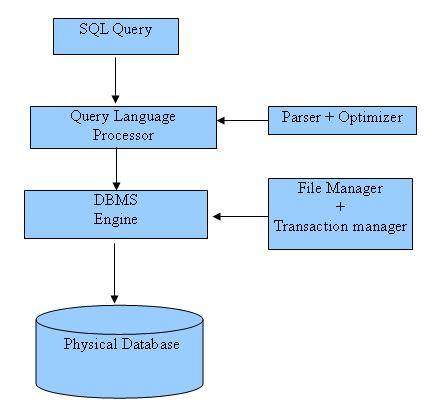SQL - Structured Query Language is a language of database, simply put its the language which a database can understand. SQL is an ANSI (American National Standards Institute) standard but there are many different versions of the SQL language.
What is SQL?
SQL is Structured Query Language, which is a computer language for storing, manipulating and retrieving data stored in relational database. SQL is the standard language for Relation Database System. All relational database management systems like MySQL, MS Access, Oracle, Sybase, Informix, postgres and SQL Server use SQL as standard database language.
Also, they are using different dialects, such as:
When you are executing an SQL command for any RDBMS, the system determines the best way to carry out your request and SQL engine figures out how to interpret the task.There are various components included in the process. These components are Query Dispatcher, Optimization Engines, Classic Query Engine and SQL Query Engine, etc. Classic query engine handles all non-SQL queries but SQL query engine won't handle logical files.
Following is a simple diagram showing SQL Architecture:

SQL Commands:
What is SQL?
SQL is Structured Query Language, which is a computer language for storing, manipulating and retrieving data stored in relational database. SQL is the standard language for Relation Database System. All relational database management systems like MySQL, MS Access, Oracle, Sybase, Informix, postgres and SQL Server use SQL as standard database language.
Also, they are using different dialects, such as:
- MS SQL Server using T-SQL,
- Oracle using PL/SQL,
- MS Access version of SQL is called JET SQL (native format) etc.
Why SQL?
- Allows users to access data in relational database management systems.
- Allows users to describe the data.
- Allows users to define the data in database and manipulate that data.
- Allows to embed within other languages using SQL modules, libraries & pre-compilers.
- Allows users to create and drop databases and tables.
- Allows users to create view, stored procedure, functions in a database.
- Allows users to set permissions on tables, procedures, and views
- 1970 -- Dr. Edgar F. "Ted" Codd of IBM is known as the father of relational databases. He described a relational model for databases.
- 1974 -- Structured Query Language appeared.
- 1978 -- IBM worked to develop Codd's ideas and released a product named System/R.
- 1986 -- IBM developed the first prototype of relational database and standardized by ANSI. The first relational database was released by Relational Software and its later becoming Oracle.
When you are executing an SQL command for any RDBMS, the system determines the best way to carry out your request and SQL engine figures out how to interpret the task.There are various components included in the process. These components are Query Dispatcher, Optimization Engines, Classic Query Engine and SQL Query Engine, etc. Classic query engine handles all non-SQL queries but SQL query engine won't handle logical files.
Following is a simple diagram showing SQL Architecture:

The standard SQL commands to interact with relational databases are CREATE, SELECT, INSERT, UPDATE, DELETE and DROP. These commands can be classified into groups based on their nature:
DDL - Data Definition Language:
DML - Data Manipulation Language:
DCL - Data Control Language:
| Command | Description |
|---|---|
| CREATE | Creates a new table, a view of a table, or other object in database |
| ALTER | Modifies an existing database object, such as a table. |
| DROP | Deletes an entire table, a view of a table or other object in the database. |
| Command | Description |
|---|---|
| SELECT | Retrieves certain records from one or more tables |
| INSERT | Creates a record |
| UPDATE | Modifies records |
| DELETE | Deletes records |
| Command | Description |
|---|---|
| GRANT | Gives a privilege to user |
| REVOKE | Takes back privileges granted from user |






